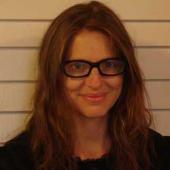Heaven and relationships
Editorial
On the heels of the national tour of my dance Heaven, created with and performed by the local, wonder-band Low, I'm reliving the whole beautiful deal in my head—and am reminded that Heaven is all about relationships.
I am obsessed with relationships—a simple duality, or a constellation of things, tethered by time. In performance, objects, people, and sound mingle and rev up a situation. My job as dance-maker is to dream these relationships into a living, moving framework.
And, in the world of dance the powerhouse relationship is between music and movement. No rules govern this epic, curious duo. I keep fantasizing about an imaginary conversation between two extraordinary American artists, John Cage, composer, who died in 1992, and Mark Morris, choreographer. Worlds apart in their approach and product, they have made significant and controversial contributions to the music/dance relationship. So, I play out a meeting in my head and come to simple conclusions: Power, feeling, coincidence, and will—all contribute to an open-ended, suspended, relational phenomenon that is delightfully difficult to pin down.
In particular, Heaven demonstrated the power of live music and dance, through a kaleidoscopic progression of upended rituals and hommages to both expressions—with primal mutterings; song and movement cycles; processional, reverent walking; choral singing; fitful running; and enduring stamina-based unison movement.
In the final moments of Heaven, the performers’ voices soar as the entire ensemble sings “Not Made With Hands,” a Sacred Harp hymn in a traditional choral formation. We see their mouths stretched wide, we hear the indelible harmonies, we feel their hearts. Placed at the end of the show, its forceful buoyant melody and dense harmonies grab the audience and deliver a critical message: when it comes to accessing ecstatic perfection, music is the portal—the fastest way to a sentient paradise, to feeling something.
After opening night in Seattle in a crowded Queen Anne bar, Lane Czaplinski, the artistic director of On The Boards, where Heaven was performed, delivered (as in deliverance) a spontaneous karaoke of "Raspberry Beret" by Prince. Lane's spontaneous choreography—gentle cupping hands, searching eyes, buckling knees—coupled with his urgent, rising voice made me fall hard for “the Beret” all over again. Outside of art, in real-life too, he nailed the perfect movement/sound relationship.
So in my nostalgic replay of the whole Heaven tour, I keep wondering what makes the epic music/dance relationship work? Speaking to three, contemporary, Minneapolis-based choreographers, Kristin Van Loon, Karen Sherman and Chris Yon—who each have experience choreographing to both other people's and their own composed sounds and scores—I find some answers.
What is your relationship to sound as a choreographer, and how does it enter or affect your process?
Kristin Van Loon (KVL): I’ve spent a lot of time, especially with Hijack, making material in the studio before music enters the equation, although we make choices early on in a project about where the music will play the role of power. I love making movement material that has its own integrity and rhythm.
Then I take an existing piece of music and shoehorn the choreography into that music’s structure, so that you have something very inorganic in which you eventually have to find an organic way to dance. I like using existing music, which can be treated like a cultural object instead of something special that is made to embrace my vision. The music is something that my vision has to come to terms with.
On the other hand, what is the benefit of making your own music?
Chris Yon (CY): I like the idea of self-sufficiency within an art practice and controlling as many aspects of the design as possible. Learning through other sound/dance collaborations, I became really opinionated about sound. At a certain point, if I wanted it a certain way, I had to do it.
I like sound as a manipulator and an amplifier. I like it as mood. I like the ability to both be really specific with cause and effect relationships with sound and what’s happening on stage. And also, [I like the] chances for that relationship to add or illicit information out of something that you wouldn’t have otherwise seen unless that sound was there.
Do you have a feeling about recognizable songs in dancing?
CY: I don’t have consistent feelings about it. Sometimes I want the music to be familiar when I want something to feel familiar, but for the most part, especially when I’m appropriating other people’s sound, it’s important to be very selective about when that music is recognizable. For the most part, I’m thinking about trying to blur it beyond recognition.
Can you explain that process?
CY: In one case, I took all of the yodeling parts from a Slim Whitman record. I dropped out the instrumentation through most of the song, and then turned the volume back on for the yodeling sections, and so then there was sort of this song cycle of weird yodeling cadenzas and choruses and riffs. So that score had its own theme and structure and runs parallel to unfolding choreographic structures.
So, how does sound operate in a dance?
Karen Sherman (KS): It depends on the project. I like the natural sound of things happening. And I like sometimes to just have something that might be musical or machine-generated, or something that’s not just the live sound of action but another kind of sound that’s maybe more emotive, that sets a tone of some sort.
I also like songs, too, but I find them trickier, because everybody has a different relationship to a song. What a song evokes for me might not evoke the same things for someone else, and with popular music there is an even greater risk of disparity.
[On the other hand] There are situations where that disparity of association might not be a problem. It’s okay if different people feel different things, or have different associations.
At what point do you know what a dance needs sonically?
KS: I have felt a connection to an idea, or section, or piece as a whole that makes me want to be creative in ways other than dance. Music is something that I used to do a lot of. I just got a lot of pleasure from it. Sometimes I’ll just want to make music and sound scores in some way, and not even think consciously about how it’s related to the project, and then I’ll have this recorded piece of something.
Like the organ piece that I made for Demolition Boy. I knew that I wanted to make something sounding fanfare-ish—a sort of ghostly haunted-house organ sort of tone. I think I initially made that for the basement piece, One Born Bad, but then it just wasn’t ever the right thing. Later on it worked for Demolition Boy.
Other times, I actively find a sonic solution for a part of the dance by searching for a specific sound that is not pre-existing.
What composer/choreographer relationships inspire you and why?
KS: James Lo and John Jasperse. I love their work together. I love Hahn Rowe. He’s worked with a lot of different people. . . But I think you’re going more for the Cage/Cunningham sort of thing. I like John Cage, and I respect Merce Cunningham and everything, but his vocabulary is just not that much my cup of tea, per se. There’s a formality and ballet base to it that doesn’t really hold my interest.
KVL: There’s no need to hesitate [for me] because Cunningham/Cage is huge, and I keep finding more to discover in considering what they did. They separated music from dance, and then brought them together at the last moment and embrace the indeterminacy and change the power dynamic in that way and elevate the status of each. I keep finding more and more in what they did.
I feel like Jerome Bel’s The Show Must Go On was a watershed moment for me. The music was all deliberately ubiquitous pop music…songs selected because he felt like they were the most universally recognized, specifically globally. The way the music was presented with the dance was that a person was sitting at a table, visibly took the CD out of the case, stuck it in the CD player. They played the whole song, he hit eject, he opened the next cd case. We saw the stack of CD cases. From the beginning the sound was a primary sculptural element. The idea of which is most important, the music or the dance, is really puzzling.
I still don’t understand it, which is why I love it.
“People and sound interpenetrate. Circumstances—a time, a place—would bring them [music and dance] together. We’ve paid our bills and the President’s been elected. Now we get down to business. The business is: to time and space our arts. A job that will keep us in a state of not knowing….analytical thinking is no help” — Composer John Cage




